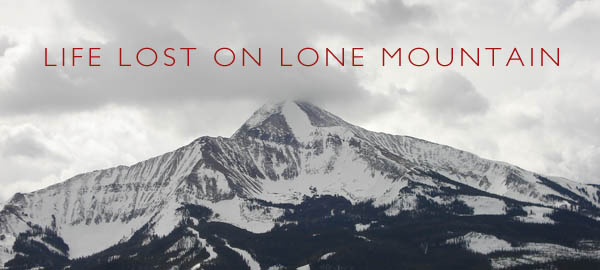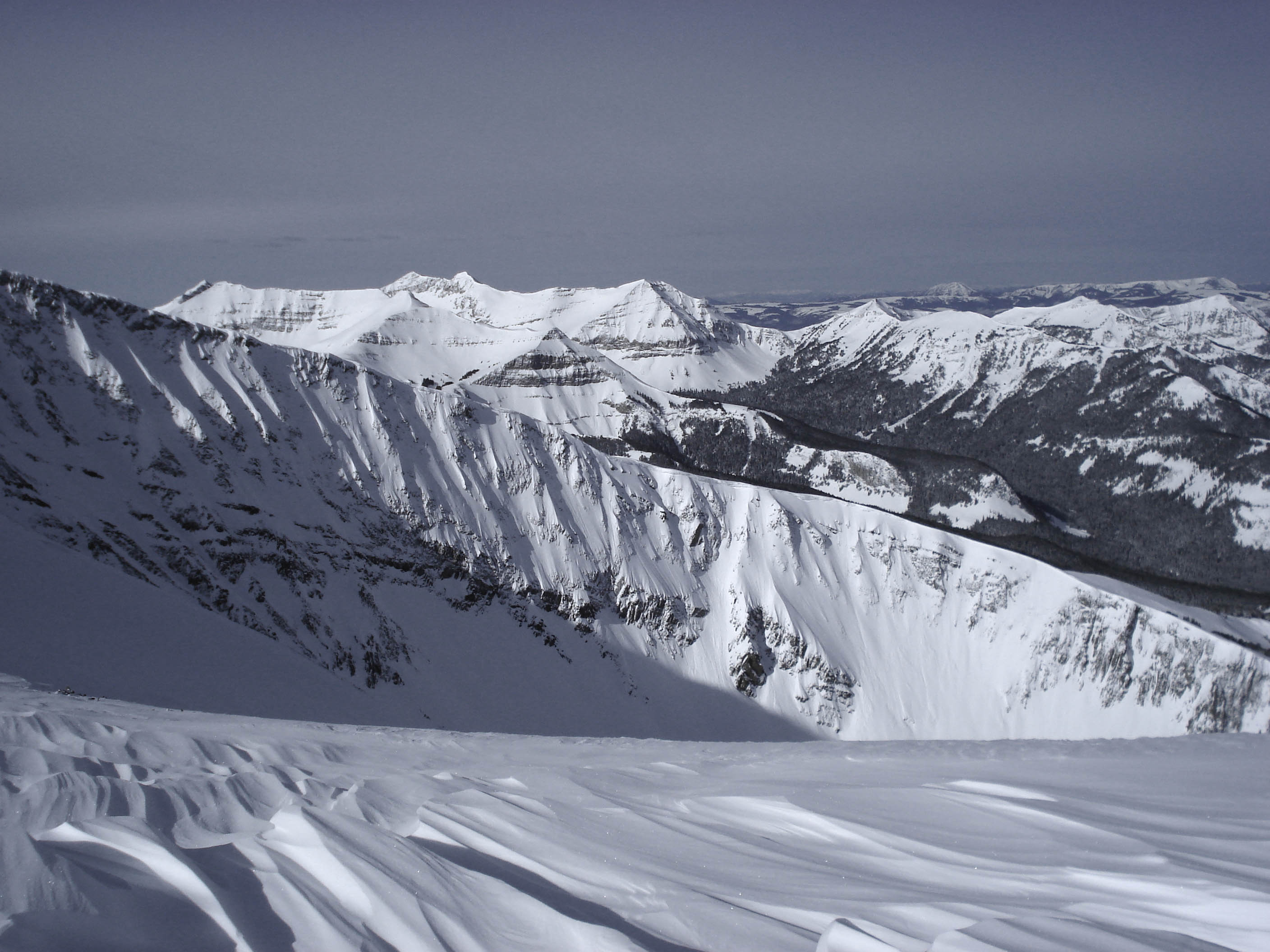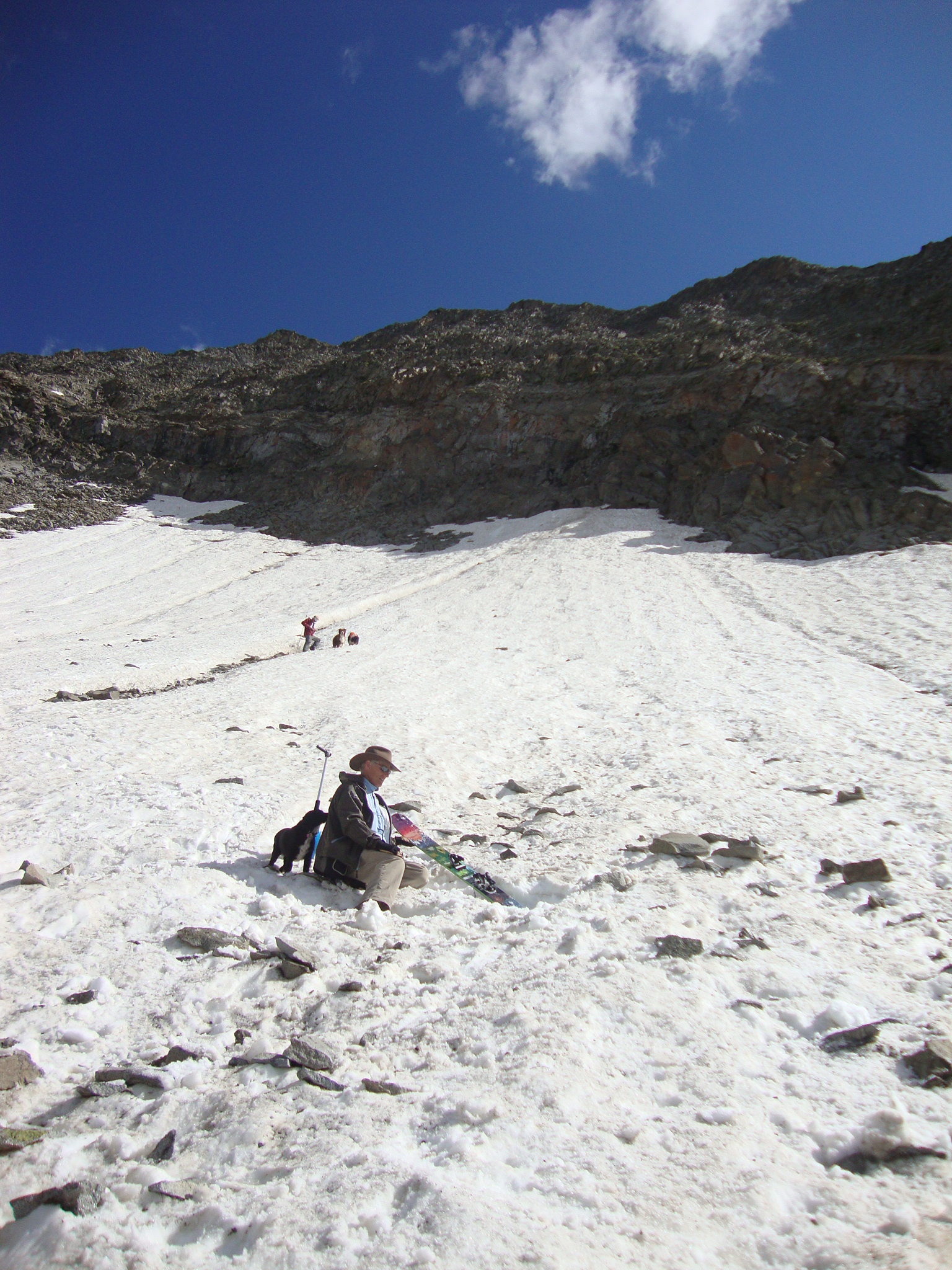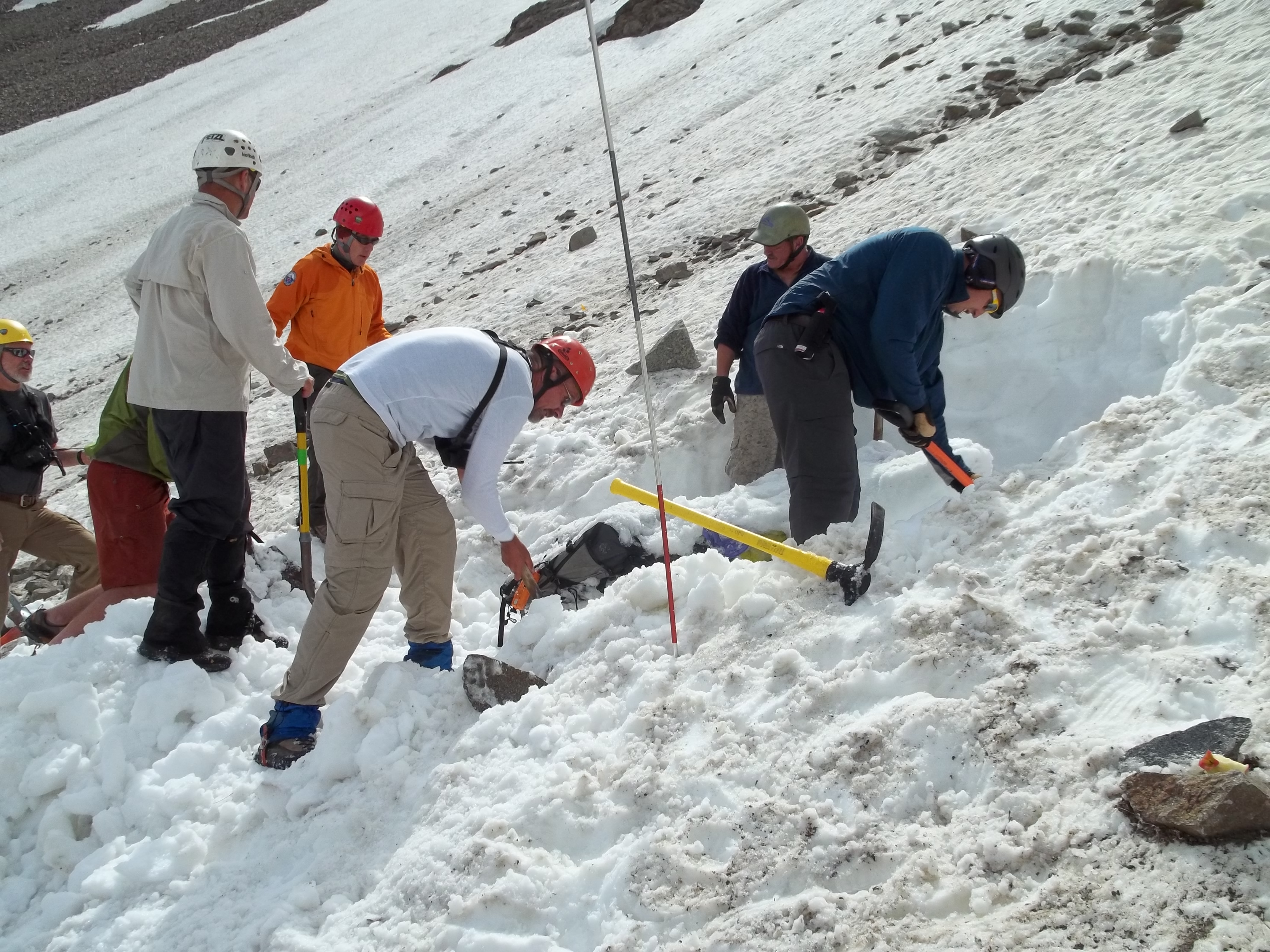Local News
Mountain Outlaw: Life Lost on Lone Mountain
Published
13 years agoon
Posted By
Admin
By Taylor W. Anderson, Mountain Outlaw Assistant Editor
Bradley Gardner lost his life at age 24 while skiing by himself on Lone Mountain on March 9, 2011. His death has sparked efforts in the Big Sky community to prevent similar events from occurring again, and will leave its stamp deeply printed on the resorts and in the backcountry ski community.
This is a story about Brad’s father Ed, his brother John, and his mother Mary. It’s for every friend who lost a dear brother in the snow-filled Montana winter of 2011.
________________
LONE LAKE CIRQUE’s 800-foot cliffs jut skyward on a hot July day, humbling the small group of people who have hiked to its base on the remote north west side of Lone Mountain. The steep-walled basin amplifies the sound of tumbling rocks.
Open snowfields are slowly melting as the sun progresses across the top of the northwest-facing cirque, and the sound of dripping water echoes quietly through the still, dry air. Ed Gardner sits near a glacial lake at the base of the cirque, staring at the mammoth area. Matt Sitton scrambles toward the crags above.
“Rock!” Sitton yells from an icy chute.
Ed doesn’t move. He just stares as the rock spins, gaining momentum down the steep slope, then bounces off the corner of a snowfield 100 feet above him. He watches straight-faced, binoculars at one hip, revolver at the other. When the rock slows to a stop 30 feet away, he raises his scopes again.
It’s a Monday in late July. Ed and Sitton have hiked the three miles up to the cirque west of Big Sky and Moonlight Basin resorts a few times this week after spring had turned to summer and winter stubbornly let go its snowy grip on the mountain.
Ed, an investment banker from Winter Haven, Florida, moved into his Big Sky condo full time when his son was reported missing on March 12. Ed last spoke with Brad on March 8, the afternoon his son launched off a 75-foot cliff on skis in the backcountry near Lone Mountain. The leap was captured on video, and Brad was ecstatic about the feat.
“He was on top of the world that night,” Ed said. Although his voice shook as he talked about his son in a coffee shop in Bozeman in July, Ed portrayed an air of strength, often smiling and laughing.
Sitton, a local photographer and Big Sky native, has hiked in the Madison Range since he was 11—two years after surgeons removed a baseball-sized tumor from the back of his brain.
He’s acted as mountain guide for Ed, and the two have grown close in the months after Brad’s disappearance.
Today, Sitton stands in hiking boots, 10,000 feet above sea level, on an eight-foot thick sheet of icy snow. He climbs another 1,000 feet above Ed to inspect what he thought was something yellow melting from the snow. “It could be nothing, but you’ve got to check out everything.”
Sitton and Brad had been friends since Brad moved to the area full time two years earlier.
“Where are you buddy? Come on out,” Sitton pleads. The pair found ski poles in the cirque only days before. One was emerging from a remaining snowfield; the other, perched on a cliff 400 feet higher.
The poles were the first raw clues in a search that began in March, almost without direction.
Big Sky Ski Patrol passed through Lone Lake Cirque and Chippewa Ridge, as well as in-bounds areas the day Brad was reported missing. The initial search included two helicopters, a fixed-wing aircraft, dog and ski units, each searching for signs of Brad.
In the first week after his disappearance, sustained high winds and heavy snowfall made the search extremely dangerous, and Big Sky Search and Rescue postponed it until conditions improved. In total, BSSR, a local volunteer group, put 300 man-days into looking for Brad. Teams covered 176 square miles, literally crossing and re-crossing paths before zeroing in on the cirque.
By July, four months after the disappearance, the organized search teams had dwindled in size, and the attitude of the mission had long since shifted from rescue to recovery. Gallatin County released a statement declaring the search wouldn’t end without success, and deputies promised they wouldn’t give up until they found Brad. The Gardners kept close contact with search and rescue, and the groups continued their independent search.
Later that week, Ed and Sitton discovered the ski poles.
Ed Gardner contacted Ed Hake, founder and president of the BSSR, after finding them. “He was at my house in 30 minutes asking if I wanted them to go up that night to recover the poles,” Gardner said.
The following day, the crew used a helicopter, supported by ground and dog units, to try and recover or photograph the cliffed pole. The crew got a high-resolution close-up of it, which only led to more confusion when the photo revealed the poles didn’t match. Rather than settle any doubt that Brad’s body was in the area, the discovery caused confusion, and search efforts hit another wall.
_____________
BRAD LIVED FOR and pursued a lifestyle that’s grown hugely popular in the past few decades: big mountain skiing and snowboarding.
He idolized big-name skiers, watched and tried to emulate their styles. He wasn’t well known in the Big Sky skiing community, but among friends he was a step above, and cliff jumps like the one he did on March 8 in the Chippewa Ridge region of Lone Mountain were hallmarks of his talent.
“I rode with him, and we rode hard,” his friend Dan Greene said. “He raged all the time.”
The lifestyle is something shared by thousands of adults in lieu of school or in limbo between graduation and the dreaded ‘corporate life.’ It’s grown popular among skiers Brad’s age that move to mountain towns and pick up jobs that allow them to pay for rent, food, winter utilities and a ski pass. Many live on a seasonal basis. One winter is snowy, the next is cold and dry, and they surf the emotional waves of waiting for good conditions.
Visits home become infrequent. Mornings are early and nights late in the search for long, epic days on the mountain or quick runs before work. They read magazines, watch movies, follow riders and fashion, emulate, repeat.
After two years living full time in the area, the lifestyle had captured Brad. Regular cliff jumps and steep chute skiing were things he shared with friends and did alone. The desire to push his limits began to drive him.
“And for what? A video? A free pair of skis?” Ed asked. “I told him, ‘If you want skis, I’ll buy you a new pair of skis. What you’re doing is stupid,” Ed said from the Bozeman coffeehouse, the steam long since finished rising from his coffee.
Ed had just dropped his wife Mary off at the Gallatin Valley airport that day. She split time between her job as a radiologist in Florida and visiting Big Sky to help search efforts off the hill.
Brad’s video from the March 8 Chippewa Ridge cliff jump showcased his skills in the adrenaline-driven world of big-mountain skiing.
“That cliff is halfway down Chippewa Ridge, and we were there filming all week,” Greene said. The area is highly trafficked in the winter months. Devilish, talus-filled cliffs in the summer make way for snow-filled chutes in the winter. What’s more, skiers can traverse easily back from the out of bounds terrain to the Dakota lift in the resort, adding to the popularity of the Chippewa Ridge.
Following a trend among western ski areas, Big Sky and Moonlight resorts added backcountry gates in 2006, allowing skiers to access nearby backcountry. With warning signs and skull and crossbones, the gates warn those leaving patrolled terrain. From atop Lone Peak, there are two routes to Chippewa.
“One’s the traditional route where you go across the snowline in the Wyoming Bowl. The second is to go above Wyoming Bowl on the [Lone Lake Cirque] ridge and come back the backside,” says Big Sky ski patrol director Bob Dixon.
This windblown ridge separates Wyoming Bowl from Lone Lake Cirque. Last winter, wind formed a massive overhanging cornice above the cirque about 700 feet below the summit, along the ridge. Beneath the cornice, cliffs drop 1,000 feet to the basin floor.
______________
BRAD WAS REPORTED missing on March 13, four days after telling friends he was going back to Chippewa Ridge. Five new inches of snow fell around Big Sky that morning, and winds were between 25-40 mph.
The mountains in the region had received significant snowfall that winter, and by March 9, the snowpack was 111 percent of average. Another 4–5 inches fell on March 11, and on March 12 winds at high elevations were recorded at 80 mph.
Both natural and skier-triggered avalanches had been reported in the backcountry that day, according
to the Gallatin National Forest Avalanche Center’s daily advisory archives. The avalanche hazard rating was ‘Considerable’ on all windloaded slopes, which meant natural avalanches were possible, and human triggered avalanches were probable. Doug Chabot, Gallatin Avalanche Center director, issued the March 9 avalanche advisory. He cautioned that “cornices will be sensitive to breaking and wind slabs will be easily triggered.”
High alpine terrain like that surrounding Lone Peak was especially susceptible to cornice build-up and wind loading, so the caution related to almost any of the backcountry Brad could have accessed from the ski area.
Brad wasn’t scanned at any lift on the resorts that day—lift-operators likely recognized him as a local and a season pass holder, and let him on without checking. There was no evidence that he was skiing in bounds. He was skiing alone, most likely on the last tram of the day. He had a backpack equipped with a shovel, avalanche beacon and candy bars. His jacket was equipped with RECCO mountain gear. He asked friends if they would come with him on a last run to Chippewa to look at the hole his body left in the snow from the jump the day before, but no one could go.
The snow was good, and at 2:30 p.m. Brad likely caught the last tram ride to the peak alone.
Wind would have swayed the tramcar as it neared the top. Brad, holding his skis at his sides, would’ve walked off at the tram dock onto the gusty summit, tossed his skis to the rubber mat flooring and clipped in. He would’ve sidestepped up, passed the Moonlight Basin summit hut, then slipped down the ridge, Liberty Bowl and then Dakota Territory to his left, the void of Lone Lake Cirque to his right. He’d have taken the same route as usual, riding the knife-edge ridge 1,000 feet as it dropped and began to bend to the north.
He would have ridden near the massive cornice, overhanging a fatal drop into the cirque. Just before the ridge bent, he would have planned to turn and ski south toward Chippewa.
_______________
DAN GREENE RENTED his condo from Ed Gardner, and called Ed after Brad didn’t come home for three days.
“His door was open and his dog was there.”
Ed Gardner and family flew to Big Sky the day Greene phoned. Ed and Mary called Big Sky Ski Patrol, which in turn called the sheriff. The family printed flyers announcing the search effort and describing Brad’s bright skiing outfit and the color of his boots and pants. “Orange boots, yellow pants,” Ed repeated.
The family passed them out throughout town, and then headed to Big Sky Resort and Moonlight Basin. By March 13, a foot of snow had fallen near Big Sky, and another 28 inches fell between the 15th and 19th. This, combined with high winds, caused the teams to call off the initial search on March 19.
John, Brad’s 22-year-old brother, left Colby College in Maine during his senior year to help search. Coordinating with Hake from the BSSR, John scanned the mountain for signs of Brad.
Taking to the mountain on skis with a small group of Brad’s friends, he bought lift tickets and covered both resorts, placing flyers, and probing and digging in the snow near Chippewa.
Ed and Mary focused mainly around Big Sky and the Madison Valley to the west.
Ed was granted access to the Jack Creek Preserve road west of Big Sky, and he and Mary traveled to Ennis early during the search to hang flyers. By the time the two got there, word had already spread about a missing person.
“They heard there was a hiker missing,” Ed said. Madison Valley residents had formed a search party and gone into the mountains on a rescue mission based out of Ennis for what they presumed was a missing resident, an event that resonates in small Montana towns.
“It says something about the people from Montana when a town reacts like that,” Ed said.
Word around Big Sky Resort was also misinformed about the specifics surrounding the search, and initial reactions by the resort could have cost time in what was originally a rescue mission, Ed says.
“Almost no one I talked to knew there was a missing skier on the mountain.”
Ed said everyone he talked to believed Brad was on a solo backcountry ski tour, not in lift-accessed backcountry areas.
For weeks, Ed believed Brad might be in bounds, perhaps injured and buried in snow. Sam Byrne, owner of the Yellowstone Club, granted the Gardner searches (both informal and formal) access of land owned by the club, and Ed Hake, who also owns a snowmobile rental business on Highway 191 near Big Sky, helped lead snowmobiles into the area.
“The YC and Moonlight were very gracious and helpful,” Ed Gardner said. He said he didn’t appreciate the treatment from Boyne, the parent company that owns Big Sky Resort.
______________
MONTHS AFTER STARTING the search, the ski season was over, but Lone Mountain looked much the same as it did throughout the winter. Spring turned to summer, and cold weather kept the mountain coated in snow for months.
John returned to school in June, and Ed was the only family member left full time in Big Sky.
His efforts remained grounded as a late spring let a mammoth winter snowpack linger through much of July. His condo across Spur Road overlooks the peak, the view a scathing daily reminder.
“I was literally just sitting, staring at that mountain, watching snow melt,” Ed said. After enough melted, Ed and Sitton began hiking on and around Lone Mountain, this time on a recovery mission of their own.
Search and rescue and the sheriff’s department had covered nearly every inch of mountain near Chippewa, Wyoming Bowl and the Dakota Territory, staying out of the cirque because of inherent danger from avalanches and falling rocks. The pair was granted access to the land surrounding Moonlight Basin, and since SAR teams had found nothing but false clues and animal tracks elsewhere, their hikes came to center on Lone Lake Cirque, on the northwest side of the mountain.
The hike started at a gravel pit near the end of the Spur Road at Moonlight Basin. There, the land crosses the boundary into the Lee Metcalf Wilderness, from which point the two followed mostly game trails for five miles and thousands of vertical feet before passing a high mountain spring and reaching the cirque.
___________
AT 11 A.M., the sun hasn’t warmed the cirque at 10,000 feet. Ed and Sitton reach the lake and sit.
A toboggan and sleeping bag—caches from the resorts’ ski patrols—hang in a tree on the bank. The air is silent and windless. There are no clouds to cast shadows during the early morning, no birds overhead. The two are alone.
Their faces lack any sense of urgency or hurry. Ed sits eating an apple and some jerky, looking up at the clifftops thousands of feet above him. Sitton takes his shirt off and spreads out one of the sleeping bags, which lie wet and bunched up on the remaining snow. They have become accustomed to this search.
They sit silently, 200 feet apart, and rest at the shores of the lake as the sun begins its westward crawl across the ridge above.
The glacial moraine in the bottom of the basin has formed a massive pile of talus covering a hidden rock glacier. Rock fields emerge from beneath the remaining snow and sprawl toward the lake, pushed by the ice hidden beneath them. Throughout the cirque, snowfields sit, just starting to warm in the midday sun. Beneath the boulder field, the tinny sound of draining water emerges as the snowmelt moves through the rocks and into the small, blue lake.
The sun has just begun its westward crawl over the ridge; it’s never hidden by the ridge. The weather shows the first sign of life in light, sustained breezes hush past for a moment, cooled by the snow and high elevation, and silence returns.
Then, a horrible sound begins. Rocks begin falling. First faint and distant, only an echo is heard as they careen through chutes and off crags, gaining speed. They’re only seen when they reach the moraine snowfields. Just pebbles.
Ed pulls out a small pair of binoculars and looks up. He points. “That’s where we found the pole.”
That day, Ed and Sitton saw four things that appeared to be remnants of Brad. A glimmering rock looked like a watch. Something yellow looked like a piece of his clothing. Each potential clue only a phantom mirage and painful memory of Brad. The only physical evidence actually on the hill that day was the ski pole (which remains today wedged between two rocks on an 800-foot cliff), and Brad’s body, still frozen just feet below his father’s boots.
______________
BRAD’S BODY WAS discovered eight days later. Ed and Sitton noticed the edge of one of Brad’s skis melting out of the snow on July 21. A thin line the size of a marker shined in the sunlight. With it, a shovel handle and a candy bar.
They called search and rescue and the Madison and Gallatin county sheriff’s departments. A meeting was assembled on Thursday, July 22, to plan the final mission into the area the following days.
Crews from the original search parties charged the mountain with force matching the March search. Some hiked to the summit, others were dropped by helicopter. All were there to probe, shovel, scour and search the snow with RECCO radar signals.
They found Brad, boot cracked and skis delaminated on July 23. He was buried in the colossal mountain cirque, likely having died from injuries after a fall when a cornice broke thousands of feet above, though investigators still aren’t certain of the details. His body was taken back to Florida for a funeral.
Sitting over a fresh cup of coffee at a hut in Big Sky three days after finding his son, Ed looked like a man incomplete. His voice displayed the echo of a father in void, and his pain hid behind a strong stare. He spoke frankly of the traumatic experience and displayed hope that from this tragedy, a flower will grow, and positive change will be made.
Ed needs time to recharge and recover, though he says he’ll likely never be whole again.
“I was talking to Brad one winter about his skiing,” Ed said. “He said to me, ‘Dad, if I die back there, you don’t have to come find me.’ And I said to him, ‘Well, I’m going to, Brad.’”
_____________________________
Taylor Anderson is Assistant Editor of Mountain Outlaw magazine. Matt Sitton, Big Sky native, owns a photo and video company in Big Sky.
To donate to Big Sky Search and Rescue visit BSSAR.org
Upcoming Events
november, 2024
Event Type :
All
All
Arts
Education
Music
Other
Sports
Event Details
Spanish Classes with World Language InitiativeThese unique, no cost Spanish classes are made possible by the contribution of Yellowstone Club
more
Event Details
Spanish Classes with World Language InitiativeThese unique, no cost Spanish classes are made possible by the contribution of Yellowstone Club Community Foundation (YCCF) and Moonlight Community Foundation (MCF). This class will focus on building a lifelong affinity for world languages and cultures through dynamic and immersive Communicative Language teaching models.
Beginner Class – Mondays and Wednesdays from 5:30-6:30 pm
Intermediate Class – Mondays and Wednesdays from 6:45- 7:45 pm
- Classes begin Oct.7, 2024 and run for 6 weeks
- Class size is limited to 12 students
- Classes are held in Big Sky at the Big Sky Medical Center in the Community Room
For more information or to register follow the link below or at info@wlimt.org.
Time
October 21 (Monday) 5:30 pm - November 27 (Wednesday) 7:45 pm
Location
Big Sky Medical Center - Community Room (2nd Floor)
Big Sky Medical Center - Community Room (2nd Floor)
Event Details
Spanish Classes with World Language InitiativeThese unique, no cost Spanish classes are made possible by the contribution of Yellowstone Club
more
Event Details
Spanish Classes with World Language InitiativeThese unique, no cost Spanish classes are made possible by the contribution of Yellowstone Club Community Foundation (YCCF) and Moonlight Community Foundation (MCF). This class will focus on building a lifelong affinity for world languages and cultures through dynamic and immersive Communicative Language teaching models.
Beginner Class – Mondays and Wednesdays from 5:30-6:30 pm
Intermediate Class – Mondays and Wednesdays from 6:45- 7:45 pm
- Classes begin Oct.7, 2024 and run for 6 weeks
- Class size is limited to 12 students
- Classes are held in Big Sky at the Big Sky Medical Center in the Community Room
For more information or to register follow the link below or at info@wlimt.org.
Time
October 28 (Monday) 5:30 pm - December 4 (Wednesday) 7:45 pm
Location
Big Sky Medical Center - Community Room (2nd Floor)
Big Sky Medical Center - Community Room (2nd Floor)
Event Details
Spanish Classes with World Language InitiativeThese unique, no cost Spanish classes are made possible by the contribution of Yellowstone Club
more
Event Details
Spanish Classes with World Language InitiativeThese unique, no cost Spanish classes are made possible by the contribution of Yellowstone Club Community Foundation (YCCF) and Moonlight Community Foundation (MCF). This class will focus on building a lifelong affinity for world languages and cultures through dynamic and immersive Communicative Language teaching models.
Beginner Class – Mondays and Wednesdays from 5:30-6:30 pm
Intermediate Class – Mondays and Wednesdays from 6:45- 7:45 pm
- Classes begin Oct.7, 2024 and run for 6 weeks
- Class size is limited to 12 students
- Classes are held in Big Sky at the Big Sky Medical Center in the Community Room
For more information or to register follow the link below or at info@wlimt.org.
Time
November 4 (Monday) 5:30 pm - December 11 (Wednesday) 7:45 pm
Location
Big Sky Medical Center - Community Room (2nd Floor)
Big Sky Medical Center - Community Room (2nd Floor)

















